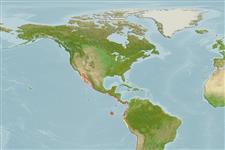Common names from other countries
>
Eupercaria/misc (Various families in series Eupercaria) >
Haemulidae (Grunts) > Haemulinae
Etymology: Haemulopsis: Greek, haimaleos = bloody + Greek, opsis = with appearance (Ref. 45335).
More on author: Steindachner.
Environment: milieu / climate zone / depth range / distribution range
Ecologia
marinhas demersal. Tropical; 32°N - 12°S, 115°W - 77°W
Eastern Pacific: Gulf of California to Peru.
Tamanho / Peso / Idade
Maturity: Lm ? range ? - ? cm
Max length : 30.0 cm TL macho/indeterminado; (Ref. 9114); common length : 25.0 cm TL macho/indeterminado; (Ref. 9114)
Descrição suscinta
Chaves de identificação | Morfologia | Morfometria
Body robust, compressed, and not very deep (depth contained 2.7 to 3.3 times in standard length); mouth small and terminal, its posterior end located at the same level as the anterior rim of the eye; first gill arch with 17 to 20 gill rakers; dorsal fin notched, with 12 spines ad 14 to 15 soft rays (XII, 14-15); second anal spine shorter than third; body silvery bronzed; scales dark edged, forming longitudinal lines along each series of scales; anterior end of lateral line with an indistinct spot (Ref. 55763).
Inhabits coastal seas, on sandy or muddy bottoms. Marketed fresh (Ref. 9114).
Ciclo de vida ou comportamento de acasalamento
Maturities | Reprodução | Spawnings | Egg(s) | Fecundities | Larvas
Oviparous, distinct pairing during breeding (Ref. 205).
McKay, R.J. and M. Schneider, 1995. Haemulidae. Burros, corocoros, chulas, gallinazos, roncos. p. 1136-1173. In W. Fischer, F. Krupp, W. Schneider, C. Sommer, K.E. Carpenter and V. Niem (eds.) Guia FAO para Identification de Especies para lo Fines de la Pesca. Pacifico Centro-Oriental. 3 Vols. FAO, Rome. (Ref. 9114)
Status na Lista Vermelha da UICN (Ref. 130435)
CITES (Ref. 128078)
Not Evaluated
Ameaça para os humanos
Harmless
Uso pelos humanos
Can't connect to MySQL database (fbapp). Errorcode: Too many connections
